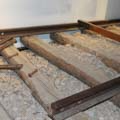You are here
Golden Spike National Historic Park
At Promontory Summit on May 10, 1869, Central Pacific official Leland Stanford pounded a gold ceremonial spike into a special tie made from polished California laurel, connecting the Central Pacific and the Union Pacific to form the nation’s first transcontinental railroad. While the joining of the railroad line from Council Bluffs, Iowa, to Sacramento, California, had profound consequences for the country as a whole, in Utah, it turned the closest sizable city, Ogden, into an important junction, transforming it from a small agrarian community into a manufacturing and transit hub. To commemorate the completion of the transcontinental railroad, Promontory Summit was designated a National Historic Site in 1957, brought under federal ownership in 1965, and declared a National Historic Park in 2019.
Golden Spike consists of a narrow stretch of desert land, measuring approximately 15.5 miles long and between 400 and 1,000 feet wide. The area is one of the few natural passes through the Rocky Mountains, here dividing the North Promontory and Promontory mountains in the northern part of the Great Lake Basin. On the 2,735-acre land (532 acres remain privately owned) are double railroad grades running parallel to each other. Since the railroad ceased operating in this area in 1942, the tracks were removed and much of the original grades have eroded although they are still visible in some places. Some of the roadbeds have since been used as roads for vehicles in some places, and are crossed by local roads in other areas. Much of the erosion is also due to grazing and other farm use by local ranchers and farmers. Near the location where the Golden Spike ceremony occurred, the National Park Service built a single-story, stone and frame Visitors’ Center, in front of which is a rebuilt road grade and new track, where two replicas of 1860s steam locomotives are on display, and where reenactments of the driving of the last spike take place annually. Much of the surrounding landscape features native growth such as sagebrush and other desert grasses and plants.
References
Writing Credits
If SAH Archipedia has been useful to you, please consider supporting it.
SAH Archipedia tells the story of the United States through its buildings, landscapes, and cities. This freely available resource empowers the public with authoritative knowledge that deepens their understanding and appreciation of the built environment. But the Society of Architectural Historians, which created SAH Archipedia with University of Virginia Press, needs your support to maintain the high-caliber research, writing, photography, cartography, editing, design, and programming that make SAH Archipedia a trusted online resource available to all who value the history of place, heritage tourism, and learning.















